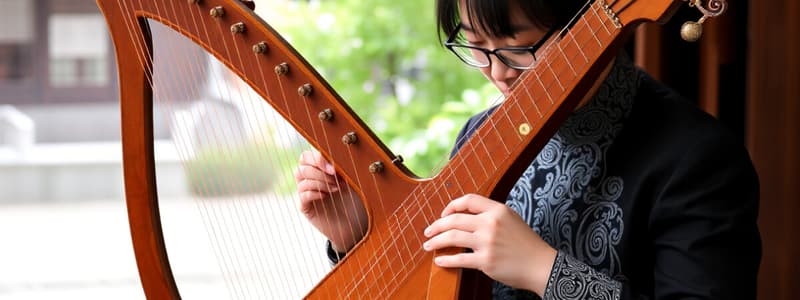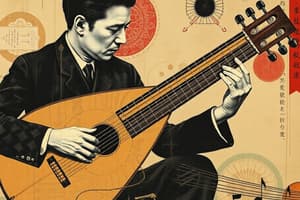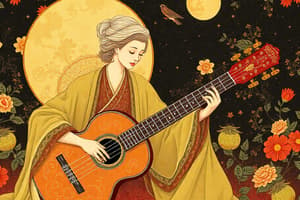Podcast
Questions and Answers
Which of the following instruments uses a hand-turned wheel to create sound by passing it over the strings?
Which of the following instruments uses a hand-turned wheel to create sound by passing it over the strings?
- Hurdy gurdy (correct)
- Sarangi
- Balalaika
- Yangqin
A musician is composing a piece intending to evoke the atmosphere of medieval Europe. Which chordophone would be MOST appropriate to include?
A musician is composing a piece intending to evoke the atmosphere of medieval Europe. Which chordophone would be MOST appropriate to include?
- Sarangi
- Medieval lute (correct)
- Berimbau
- Yangqin
An ethnomusicologist is studying the origins of hammered dulcimers. Based on the information, which instrument is the MOST likely ancestor of the Chinese yangqin?
An ethnomusicologist is studying the origins of hammered dulcimers. Based on the information, which instrument is the MOST likely ancestor of the Chinese yangqin?
- Balalaika
- European zither
- Persian dulcimer (correct)
- Irish harp
A composer wants to create a piece that utilizes sympathetic strings to produce a complex sound. Which instrument would BEST achieve this effect?
A composer wants to create a piece that utilizes sympathetic strings to produce a complex sound. Which instrument would BEST achieve this effect?
A musicologist is tracing the evolution of the zither. According to the text, which region's instruments are MOST likely the historical predecessors of the European zither?
A musicologist is tracing the evolution of the zither. According to the text, which region's instruments are MOST likely the historical predecessors of the European zither?
A film composer is working on a soundtrack for a movie about capoeira martial arts. Which instrument would be the MOST authentic choice to represent the musical traditions associated with this art form?
A film composer is working on a soundtrack for a movie about capoeira martial arts. Which instrument would be the MOST authentic choice to represent the musical traditions associated with this art form?
If an instrument has strings stretched from one end of a bow to the other, what type of chordophone is it?
If an instrument has strings stretched from one end of a bow to the other, what type of chordophone is it?
A musician is interested in playing a Russian folk instrument with a triangular body. What instrument would they MOST likely be playing?
A musician is interested in playing a Russian folk instrument with a triangular body. What instrument would they MOST likely be playing?
Which of the following best describes the contemporary adaptation of pipa playing technique?
Which of the following best describes the contemporary adaptation of pipa playing technique?
A musician is categorizing instruments based on the traditional Chinese classification system. Which category would a set of cymbals belong to?
A musician is categorizing instruments based on the traditional Chinese classification system. Which category would a set of cymbals belong to?
How does the design of the pipa's fretboard contribute to its versatility?
How does the design of the pipa's fretboard contribute to its versatility?
Why is Liu Fang considered a significant figure in the world of pipa music?
Why is Liu Fang considered a significant figure in the world of pipa music?
What is the primary mechanism by which chordophones, like the pipa, produce sound?
What is the primary mechanism by which chordophones, like the pipa, produce sound?
If a musician is interested in playing an instrument categorized under the 'silk' classification of traditional Chinese instruments, which of the following would be suitable?
If a musician is interested in playing an instrument categorized under the 'silk' classification of traditional Chinese instruments, which of the following would be suitable?
Which of the following musical instrument belongs to the 'hide' category in the traditional Chinese instrument classification?
Which of the following musical instrument belongs to the 'hide' category in the traditional Chinese instrument classification?
Based on the information, what is a key physical characteristic that distinguishes the pipa from other stringed instruments?
Based on the information, what is a key physical characteristic that distinguishes the pipa from other stringed instruments?
Flashcards
Chordophones
Chordophones
Instruments that produce sound through vibrating strings.
Resonator
Resonator
A hollow part of an instrument that vibrates with the strings, creating a richer sound.
Lutes
Lutes
Strings stretched over a resonator and along a neck. (e.g., guitars, violins)
Zithers
Zithers
Signup and view all the flashcards
Harps
Harps
Signup and view all the flashcards
Lyres
Lyres
Signup and view all the flashcards
Musical Bows
Musical Bows
Signup and view all the flashcards
Balalaika
Balalaika
Signup and view all the flashcards
Pipa
Pipa
Signup and view all the flashcards
Chinese Instruments
Chinese Instruments
Signup and view all the flashcards
Silk Instruments
Silk Instruments
Signup and view all the flashcards
Bamboo Instruments
Bamboo Instruments
Signup and view all the flashcards
Wood Instruments
Wood Instruments
Signup and view all the flashcards
Stone Instruments
Stone Instruments
Signup and view all the flashcards
Liu Fang
Liu Fang
Signup and view all the flashcards
Study Notes
- Pipa strings rattle like rain, and hum like a hushed whisper.
- Bai Juyi, a Tang Dynasty poet, wrote this.
- The pipa is a four-stringed, pear-shaped instrument similar to a lute.
- It is a popular instrument, over 2,000 years old, played throughout China.
- A pipa player moves their fingers nimbly to play the instrument well.
- The instrument is held pointing upward.
- The left hand moves up and down the frets, pushing, twisting, and pulling the strings.
- The player's five fingers on the right hand alternate between plucking the strings forward and backward.
- Liu Fang is a famous pipa player who performs solo concerts worldwide.
- She began playing at six, gave public concerts by nine, and performed for Queen Elizabeth II at 11.
- Liu Fang plays Western classical music and traditional Chinese music, combining both musical traditions.
- The pipa has a short, bent neck with up to 30 frets extending onto the soundboard, offering a wide range of 3½ octaves.
- Until the 20th century, players used their fingernails to pluck soft, twisted silk strings.
- Pipa strings are now made of steel with nylon wound around them, making them too tough for human fingernails.
- Musicians use elastic tape to fix false nails made of plastic to their fingertips when playing the pipa.
- Stringed instruments, known as chordophones, have developed into various shapes and sizes since ancient times.
- These instruments produce sounds by vibrating strings.
- Strings can be played with a bow, plucked with fingers, or struck with hammers.
- Most chordophones have strings stretched across a resonator, which is the hollow part that vibrates along with the strings, creating a richer sound.
Five Basic Types of Chordophones
- Lutes: Strings are stretched over a resonator and along a neck, like guitars and violins.
- Zithers: Strings are stretched over or inside a resonator, or between two resonators.
- Harps: Strings are slanted within a frame.
- Lyres: Strings are raised on a bar above the resonator.
- Musical Bows: Strings are stretched from one end of a bow to the other.
- Yangqin, from 18th century China, a trapezium-shaped instrument is the Chinese version of the hammered dulcimer originally from Persia (modern-day Iran); the strings are struck with bamboo beaters.
- Medieval lute, c.1350-1400, Europe was very popular, accompanying songs in medieval Europe, and continued to be heard during the Renaissance and Baroque periods.
- Lutes fell out of favor in the early 1800s but have seen a revival of interest in modern times.
- Balalaika, 18th century, Russia is a Russian folk instrument has a characteristic triangular body and three strings.
- There are at least six sizes of balalaika varying from low to high pitch.
- Early Chinese music utilizes a five-note (pentatonic) scale.
- Zither, 5th century BCE, China: The European zither shown can have up to 45 strings and has evolved from instruments played in China over 2,500 years ago.
- It is played in Slovenia, Austria, Hungary, and southern Germany.
- Irish harp, 9th century, Ireland: This small, portable harp is a popular instrument in Celtic folk music.
- Hurdy gurdy, 10th century, Europe is a mechanical violin: this medieval instrument makes a sound by a hand-turned wheel passing over the strings.
- Small wooden wedges are pressed to change the pitch of the strings.
- Krar, c.2000 BCE, Ethiopia: This decorated six-stringed, bowl-shaped lyre was often used to accompany songs.
- Berimbau, 16th century, Brazil is based on stringed instruments from Africa, the berimbau is the main instrument for Brazil's capoeira martial arts music.
- Sarangi, 17th century, South Asia is used for both folk and Hindustani classical music.
- The sarangi has three main strings and more than 30 "sympathetic" strings that vibrate to create a complex sound.
Studying That Suits You
Use AI to generate personalized quizzes and flashcards to suit your learning preferences.




